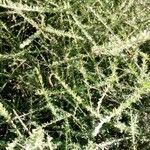Woody herb with many ascending shoots from spreading underground runners or a bushy shrub up to 5 m. tall.. Twigs grey, pilose, later glabrescent.. Leaves disposed in fascicles along the twigs, subsessile, simple; blade obovate-oblong or oblong-elliptic, rarely exceeding 8–26 mm. long, 3–8 mm, wide, apically rounded to acute, pilose on both surfaces or subglabrous, with the midrib prominent beneath.. Flowers usually solitary in the axils of the clustered leaves; pedicels 10–17 mm. long, purplish-pilose.. Sepals 8–11 mm. long, acute, green, pilose outside; receptacle about 2–3 mm. long, brown, pilose; disk without a prominent free rim.. Petals usuallypresent, 2–4 mm. long.. Stamens 19–24; filaments 15–18 mm. long, greenish-white.. Ovary narrowly cylindrical, minutely puberulous or appearing glabrous.. Fruits cylindrical, 2–4.5 cm. long, markedly torulose, glabrous or pubescent.
Leaves alternate or fasciculate on abbreviated side shoots, simple; lamina 0.2–1.5 x 0.15–0.65 cm., narrowly oblong-obovate to elliptic, apex rounded or emarginate, mucronulate, base rounded or broadly cuneate, both sides hairy with a dense crisped pubescence, or with longer patent hairs particularly on the midrib, or almost glabrous with a dense or sparse scattering of minute papillae on both sides most readily visible in the more glabrescent forms, nerves in 4–5 pairs, not prominent; petiole c. 1 mm. long, invariably pubescent or with longer patent hairs.
A small shrub. It grows 2 m tall. The branches are stiff and rigid. There can be hairs. The leaves are alternate on short side branches. The leaf is simple and up to 1,5 cm long by 0.5 cm wide. They are narrowly oval. The flowers occur singly or in pairs on short side shoots. The fruit are 4.5 cm long by 0.7 cm wide. They are hairy. They hang down and are constricted between the seeds.
Spreading, virgate shrub, up to 2 m high. Leaves simple, obovate, 4-30 x 1-15 mm, petioles 5-15 mm long. Petals (0-3)4. Fruit cylindric, torulose or moniliform, ending in a sharp apex. Flowers white.
Receptacle c. 3.5 mm. long, 1.5–2 mm. wide at the mouth, cylindric, pubescent outside, slightly thickened and with a few dentate processes at the margin within.
Flowers solitary or in pairs on the abbreviated lateral shoots; pedicels up to 1.6 cm. long, pubescent or glabrescent; bracts minute, setiform.
Small shrub up to c. 2 m. tall; branches stiff and rigid, closely pubescent, glabrescent or with patent, rather long hairs on the young parts.
Ovary on a gynophore c. 3 cm. long, narrowly oblong-cylindric; ovules c. 10 on 2 placentas; stigma sessile, subcapitate.
Fruit c. 4.5 x 0.7 cm., cylindric, torulose, narrowed abruptly to a pointed apex, minutely but densely puberulous.
Sepals c. 7 x 4 mm., oblong-elliptic, apex rounded and apiculate, more or less pubescent outside.
Petals white, 2.5 x 1.5 mm., elliptic, shortly clawed at the base, margin puberulous.
Seeds 2-several, c. 6 mm. in diam., subglobose; testa pale brown, roughened.
Stamens 15–25; filaments c. 1.5 cm. long; anthers 1.75 x 0.75 mm., oblong.
Androgynophore c. 4 mm. long, shortly exserted from the receptacle.


